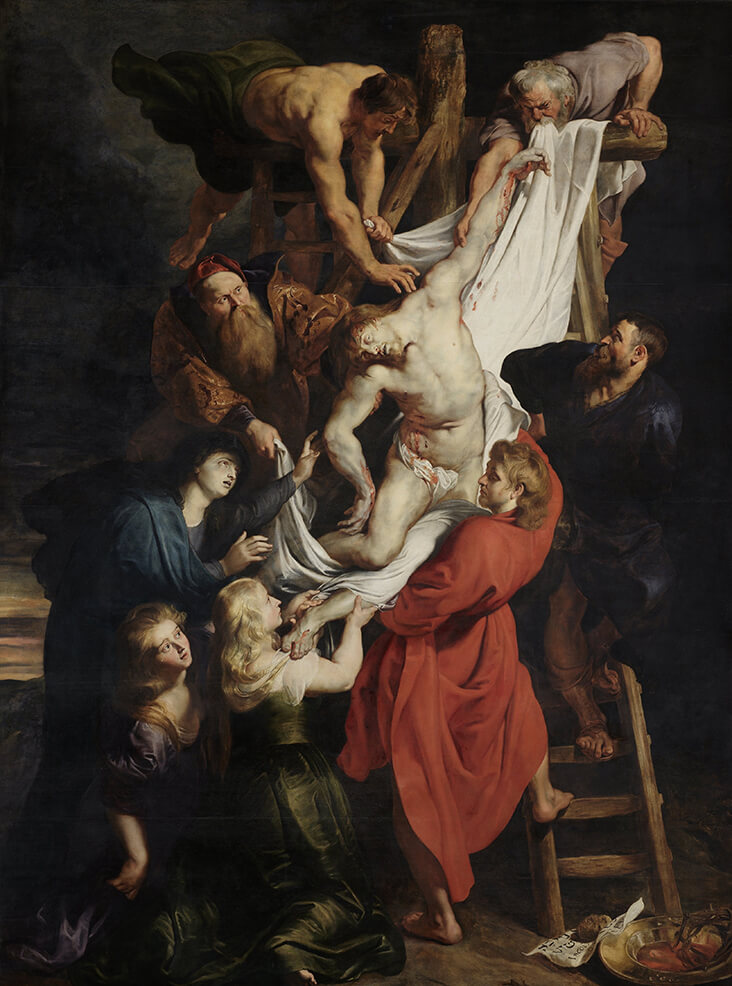FS Colour Series: Spice inspired by Peter Paul Rubens’ Blazing Fire
Fabric in the shade of SPICE Linen became billowing plumes of fire in the hands of Flemish master Peter Paul Rubens, bursting out of the darkness like sparks of light. Leader in the Baroque style, Rubens’ canvases were charged with emotive, sensual energy and movement, as theatrically staged figures are engulfed in epic swathes of heavy, indulgent fabric. Blazing shades of red, terracotta and burnt orange were strategically placed for dramatic effect, helping to tell seductive, tragic or terrifying stories by drawing our eye to the centre of the action.
Rubens was born in the German city of Siegen in 1577. The family moved to Cologne, and later, following his father’s death in 1587, Rubens moved to Antwerp with his mother. His strict Catholic upbringing would stay with him for life, colouring much of his most successful work, so much so that Rubens even became a powerful voice for the Catholic Counter-Reformation as an adult.
When he was just fourteen years old, Rubens began his artistic apprenticeship with Tobias Verhaeght in Antwerp, moving on to study under the city’s leading painters, Adam van Noort and Otto van Veen. He spent much of his early career learning through copying Renaissance masterpieces by Hans Holbein the Younger and Marcantonio Raimondi, which taught him all he needed to know about human anatomy and the sweeping swells of dynamic drapery; by 1598, he was ready to begin his career as an independent master.
In 1600 Rubens made a lifechanging trip to Italy, where he encountered great masterpieces by Titian, Veronese and Tintoretto, which had a sense of emotional, sensuous energy that he had never before encountered in art. Remaining in Italy for the next few years, Rubens went on to study classical Greek and Roman art, and copied works of art by the leading Italian masters.
Following the death of his mother, Rubens returned to Antwerp in 1608. There he was made court painter to Albert and Isabella, the governors of the low countries. His paintings from this period reveal the influence of the Italian Renaissance, but with an even greater emphasis on free-flowing fabric and dynamically charged figures. The Descent from the Cross, 1616-17, illustrates the tragic Biblical scene, heightening the story’s devastating grief with grandiose gestures in figures and drapes. Dazzlingly vivid, blood orange fabric pulls our eye to the centre of the scene, where Christ’s pale legs dangle, and we are led by a softer shade of earthy, moss green to the blindingly white centre, where Christ’s saintly body is engulfed in a blinding aura of light, as the life seems to fall from his limp body.

The Virgin and Christ Child with Saint Elizabeth and John the Baptist / Sir Peter Paul Rubens / Ca 1612
The Assumption of Mary, 1622 is even more decadent as Mary is pushed towards heaven by theatrical, swirling gusts of wind. A dramatic triangle of earthy, autumnal red sweeps around the left foreground, echoing a crumpled drape in the upper left, a reminder of the spilt blood and suffering that came to define Mary’s extraordinary life. Along with his devotional Biblical scenes, Rubens was also a much sought-after portraitist; Portrait of Susanna Lunden, 1625 is one of his most enigmatic portrayals, capturing the young daughter of Antwerp merchant Daniel Fourment, an old friend of the artist. Rubens was clearly fascinated by the young lady, capturing her brimming with nervous anticipation in muted blacks and moss greens, set alight by sensual flares of spicy, burnt sienna across her arms, a colour mirrored in her lips. Just a few years later, Rubens married Susannah’s younger sister, who was just 16, while he was 52.
As his success grew, Rubens brough an ever more expressive and painterly language into his art, leaving areas with a loose finish or visible paint marks, a trick he realised could accentuate the mystical, atmospheric effects of his scenes. In The Annunciation, 1628, the Biblical story is portrayed with fluid, hazy fabric that seems to melt into its surroundings like a spiritual aura. Angels and cherubs wrap a warm, terracotta cave around an iridescent young Mary as if folding her up into a new world, one that is burning with untold mystery, agony and wonder.





















































Leave a comment